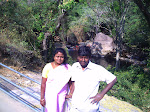Virarajendran Archaeological and Historical Research Centre
·
NEW
STONE AGE TOOLS, TAMIL BRAHMI
LETTER, GRAFFTI MARKS, HOPSCOTCHES,
SLINGSTONES,
·
GLASS BEADS
DISCOVERED.
The
research team from virarajendran Archaeologicl and
Historical Research Centre from
Tiruppur has collected
archeological evidences of an
Ancient Settlement at
Sengathurai village
In Sulur Taluk of
Coimbatore district. The team
consisted of their
Field Work Co-ordinator
S.Sathasivam,
S.Velusamy, V.Nagarajganeshkumar,
K.Ponnusamy and Er.S.Ravikumar visited
the
Banks of NOYYAL RIVER
at Sengathurai which is 4 k.m. North
of Sulur Air
Force Station and
collected the New
Stone Age tools, broken
pieces of potteries
with Tamil Brahmi
Letter, Graffti marks,
Bangles made of
Conch, Grinding stones
and some precious
stones in their
on the surface
research. Sathasivam further
said, The last
part of the
stone age is traditionally
known
As NEOLITHIC or NEW STONE AGE. The
scholars had identified
this age as
the period which
Witnessed the beginning
of cultivation and
culmation of usage
of polished lithic
implements.
Later on usage
of metals in
making tools emerged
in the copper age, Bronze age, and
Iron age.
The survey
of Neolithic Culture
indicates that from
7000 BCE to 5000BCE it was
limited to rearing
Sheep and goats, but by 3000BCE it included Cattle,
Cultivation of Domesticated Plants, permanently or
Semi-permanently
inhabited settlements and the use of pottery and ground-stone tools
rather than flaked ones. They employed
POLISHED STONE TOOLS for cutting as well as dressing the wood,used fully
Ground stone implements for hunting and tilling the
soil.Here in sengathurai we traced two New Stone
Age tools which is of polished one which is around 3000
years old. So,sengathurai was in-habited for
3000 years from
now. The stone Len gth Width Tkickness 11cm, 5cm, 2cm and
8cm, 5c.m and 2.5cm t.k. GRAFFITI ON POTTERY. Study of graffiti was initated by BRANFIL,
YAZDHANI, B.K.THAPAR , B.B.LAL,
S.GURUMURTHY and Dr.K.RAJAN. They were of the opinion that the graffiti
represents 1. The symbols of potters 2.
Symbols of the pot owner and 3. Totemic symbols. The study of the graffiti marks on the
potsherds throw valuable light on the living condition of the people in that
area.Here we find pottery with TAMIL BRAHMI letter Ma and various graffiti
marks as shown in the picture. This might be around 2600 years old. The pottery collected from
our findings consists of 1.Black & Red ware 2.Russet coated painted
ware 3.Red ware. HOPSCOTCHES: Hopscothes
are flat potshards grounded in all the sides to make it circular the children
used them to play games.Hopping on one foot from one end and pushing the round
objects over scotches (lines) to the other end is the objective of the game.
Here we collected 4 hopscotches relating to 3rd century B.C. SLINGSTONE:- Spheroid balls are generally
small in size and finely smoothened all over. These could have been used as
playing balls or for attacking small animals like birds etc. They were probably
used for grinding powder etc. INDUSTRIAL COMPLEX:- Many residues of iron ore were found on the
field. Broken pieces of bangles made of conch, Glass Beads of various colours
were collected from the site. The occurance of glass beads and their different
shapes manufacturing technique and raw materials for their manufacture shows
the possibility of existence of industries in manufacturing Iron and Steel,
Textiles, Bangles and Beads from Semi-Precious stones in sengathurai from this we come to the conclusion that
sengathurai was once an ancient trade route settlement village and the romans
entered Kongunadu belt after reaching the west coast through the palghat pass
and trade routes existed through this region to the eastern side of the state
as it was strong in trading of materials. Kongunadu fell on the trade route of
Greeks and Romans who would travel through this region to Madurai, Uraiyur and
other places in the south. Sathasivam further said in Tamil the word THURAI
refers to market where people assemble to buy and sell their
commodities.so,there will be always huge sound. In TAMIL CLASSICAL LITERATURE PURANANOORU the song no.204 refers that
cattle will often go to the river bed for drinking water. By the time the
cattle shatters the water and the water looks reddish. So the word sengathurai
may be formed from these views. So from this we come to the conculsion that
this village is habited for more than3000 years from now and the findings arenothing
but only THE REMAINDERS (RESIDUE) OF NOYYAL VALLEY CIVILIZATION.










